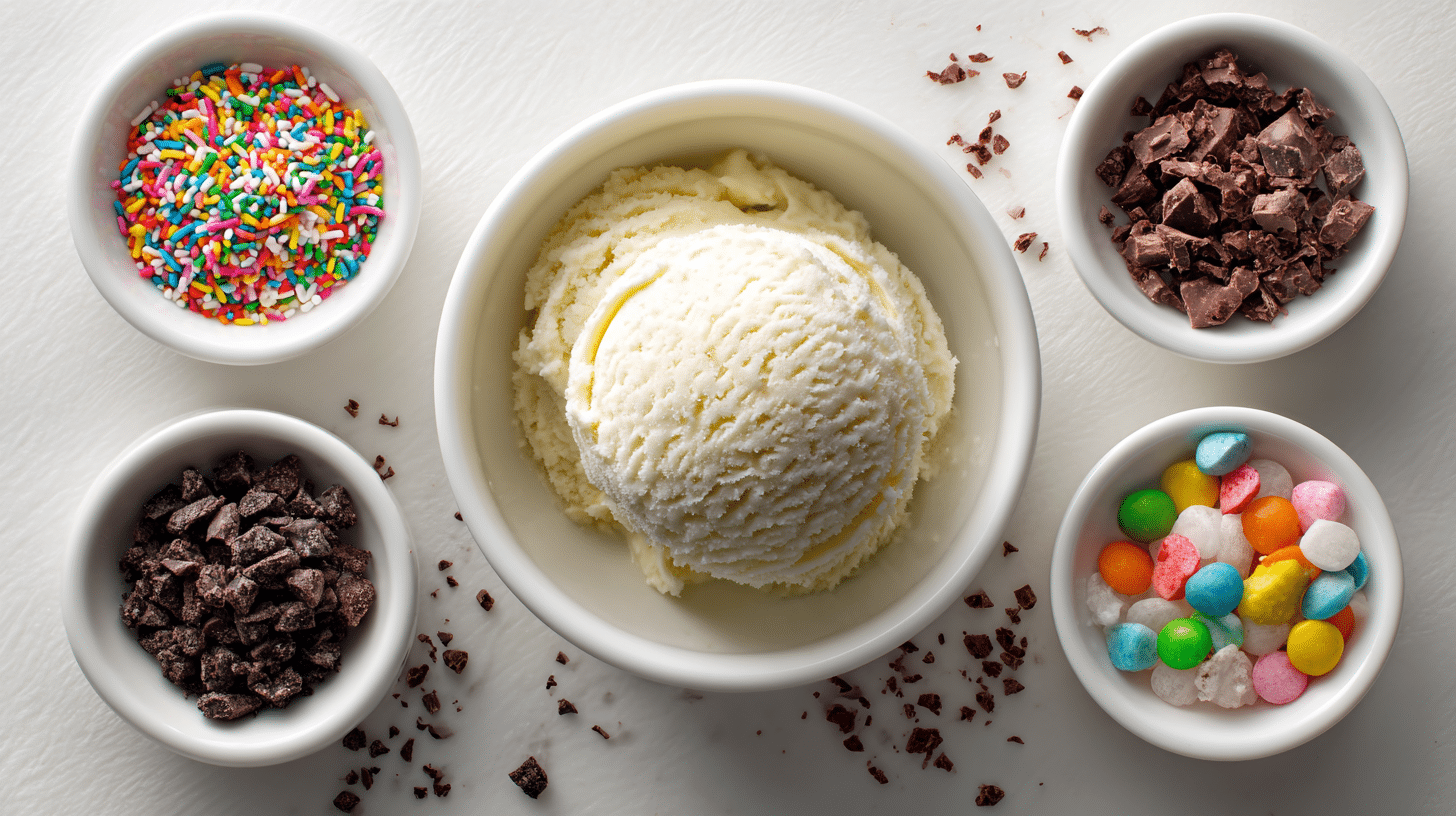You’re standing in line at your favorite ice cream shop on a hot summer day, mouth watering as you scan the colorful display of frozen treats.
But if you have celiac disease or gluten sensitivity, that moment of anticipation quickly turns into anxiety.
Which flavors are safe? What about cross-contamination? Can you even trust that “plain vanilla” is truly gluten-free?
This guide will give you everything you need to confidently enjoy ice cream again – from understanding which ingredients to watch for, to knowing exactly what questions to ask at your local ice cream shop.
Does Ice Cream Have Gluten?
Pure ice cream made with basic ingredients is naturally gluten-free. The core components – milk, cream, sugar, and sometimes eggs – contain no gluten whatsoever.
Classic flavors like vanilla, chocolate, and strawberry typically remain safe choices for people with celiac disease or gluten sensitivity.
However, the answer becomes more complex depending on specific flavors, mix-ins, and manufacturing processes.
Problems arise when manufacturers add cookie pieces, cake chunks, malted ingredients, or certain thickeners and artificial flavors.
Additionally, cross-contamination during production or at ice cream shops can introduce gluten even into otherwise safe flavors.
The key is understanding which varieties to choose and what questions to ask to ensure your frozen treat won’t cause unwanted health issues.
When Gluten Might Be Present

While pure ice cream is gluten-free, problems arise when manufacturers add certain ingredients or flavors. Here’s what to watch for:
1. Common Gluten-Containing Mix-ins
Cookie pieces, brownies, cake chunks, and wafers are obvious sources of gluten in ice cream. Graham cracker swirls and pretzel pieces also pose significant risks for those avoiding gluten.
High-risk additions include:
- Cookie pieces or cookie dough
- Brownies or cake pieces
- Wafers or cones mixed into the ice cream
- Graham cracker swirls
- Pretzel pieces
Always check ingredient lists carefully when choosing flavors with visible mix-ins or chunks.
2. Malted Flavors Are Red Flags
Malt typically comes from barley, making it a major source of gluten in ice cream. Even small amounts can trigger serious symptoms in people with celiac disease.
Avoid these entirely if you have celiac disease:
- Malted vanilla
- Chocolate malt
- Any flavor containing “malt” in the name
When in doubt about malt-containing flavors, choose a different option to stay safe.
3. Hidden Sources of Gluten
Thickening agents, stabilizers, and certain artificial flavors can contain gluten or be cross-contaminated. These ingredients are less obvious but equally important to consider when choosing ice cream.
Less obvious culprits include:
- Thickening agents
- Artificial flavors and colorings
- Stabilizers
- Some natural flavors
Reading ingredient labels thoroughly helps identify these potential hidden sources of gluten.
Types of Ice Cream to Watch

Understanding which varieties pose the highest risk helps you make safer choices.
|
Malted ice creams – Nearly always contain gluten due to malted barley. This includes popular flavors like malted vanilla or chocolate malt. Ice cream bars and cones – The coating, wafers, or cone portions almost always contain gluten. Even if the ice cream itself is gluten-free, these components make the entire treat unsafe. Specialty flavors with mix-ins – Birthday cake, cookies and cream, or any flavor with visible pieces of baked goods should be avoided unless specifically labeled gluten-free. |
Toppings That Add Risk
Be cautious with:
- Sprinkles (often contain gluten)
- Chocolate chunks (check ingredients)
- Cookie crumbles
- Candy pieces that might contain wheat
Even if you choose a safe ice cream flavor, these toppings can introduce gluten and cause problems.
Cross Contamination Risks
This is where things get tricky, even with naturally gluten-free flavors.
1. Manufacturing Concerns
Facility contamination occurs when ice cream is made in plants that also process gluten-containing products. Shared equipment can transfer tiny amounts of gluten between products.
2. Ice Cream Shop Hazards
Shared scoops and utensils are major contamination sources. That same scoop used for cookies and cream gets dipped into vanilla, potentially transferring gluten.
Display case cross-contact happens when toppings fall from one flavor into another, or when scoops accidentally touch multiple flavors.
What This Means for You: Even naturally gluten-free flavors can become unsafe through contamination during manufacturing or serving. This makes careful selection and informed questioning essential for your safety.
Best Gluten-Free Ice Cream Brands & Flavors
Many companies now recognize the need for clearly labeled gluten-free options. Here are reliable choices:
Trusted Brand Options
| Brand | Gluten-Free Highlights |
|---|---|
| Häagen-Dazs | Vanilla, Chocolate, Strawberry, Salted Caramel (tubs & bars) |
| Ben & Jerry’s | Berry Berry Extraordinary Sorbet, select Chocolate and Butter Pecan flavors |
| Nuii | Multiple ice cream stick flavors (always check labels) |
| Breyers | Several certified gluten-free flavors are available |
| Coles (Australia) | Vanilla and Neapolitan options |
What to Look For
Certification labels are your best friend. Look for:
- “Certified Gluten-Free” logos
- “Gluten-Free” prominently displayed on packaging
- Ingredient lists that specifically call out gluten-free status
Pro tip: Even within trusted brands, not every flavor is safe. Always read labels for each specific product you’re considering.
What to Do as a Person with Celiac Disease in an Ice Cream Shop

Visiting ice cream shops doesn’t have to be stressful when you follow these systematic steps to ensure your safety.
Step 1: Ask the Right Questions
Start by identifying safe options before making any decisions. Ask staff which flavors are certified gluten-free and whether they use separate equipment for these options.
Essential questions include inquiring about separate scoops, requesting clean equipment from the back, and asking about gluten-free cone options.
Step 2: Request Proper Safety Measures
Always choose a bowl instead of a cone unless certified gluten-free cones are available, and skip toppings unless they’re specifically labeled safe.
Consider bringing your own cone for complete control over potential contamination sources. These precautions significantly reduce your risk of cross-contamination.
Step 3: Trust Your Instincts and Communicate Clearly
If staff seem unfamiliar with gluten concerns or can’t answer basic safety questions, consider safer alternatives like single-ingredient sorbets or pre-packaged certified products.
Be friendly but firm about your needs, explaining briefly that you have celiac disease and even tiny amounts of gluten can cause serious illness.
Clear communication helps staff understand the importance of keeping you safe, and thanking cooperative staff encourages good practices for future customers.
Your Action Plan for Safe Ice Cream Enjoyment
Now that you understand the risks and solutions, here’s how to put this knowledge into practice:
1. Research Before You Go
Research ice cream shops in your area that have good reputations for handling dietary restrictions. Check brand websites for their most current gluten-free flavor lists, as formulations can change seasonally.
Consider calling ahead to ask about their gluten-free practices – this simple step can save you disappointment and potential health risks later.
2. Master the In-Store Strategy
Always read ingredient labels carefully, even for flavors you’ve bought before, as manufacturers sometimes change recipes.
Don’t hesitate to ask detailed questions about ingredients and preparation methods – knowledgeable staff will appreciate your thoroughness.
Choose certified gluten-free options when available, as these provide the highest level of safety assurance.
3. Build Confidence Over Time
Start with the safest options, like certified gluten-free products from trusted brands, to build your comfort level.
Keep a running list of flavors and brands that work well for you, creating your own personal “safe choices” guide.
Share your positive experiences with other people who need gluten-free options – your discoveries can help build a supportive community of safe ice cream lovers.
Enjoy Ice Cream Safely and Confidently
Living gluten-free doesn’t mean giving up one of summer’s greatest pleasures. With the right knowledge and a few simple precautions, you can enjoy ice cream safely and confidently.
The key is understanding that while basic ice cream ingredients are naturally safe, potential problems come from mix-ins, contamination, and hidden gluten sources.
Remember, your comfort level matters most. When in doubt, choose the safest option available, and don’t let anyone pressure you into taking unnecessary risks with your health.
What’s your go-to strategy for enjoying ice cream safely? Share your favorite gluten-free flavors or ice cream shop experiences in the comments; your tips might help someone else discover their new favorite treat!

























